transmission oil JEEP PATRIOT 2016 1.G Owners Manual
[x] Cancel search | Manufacturer: JEEP, Model Year: 2016, Model line: PATRIOT, Model: JEEP PATRIOT 2016 1.GPages: 587, PDF Size: 3.61 MB
Page 98 of 587
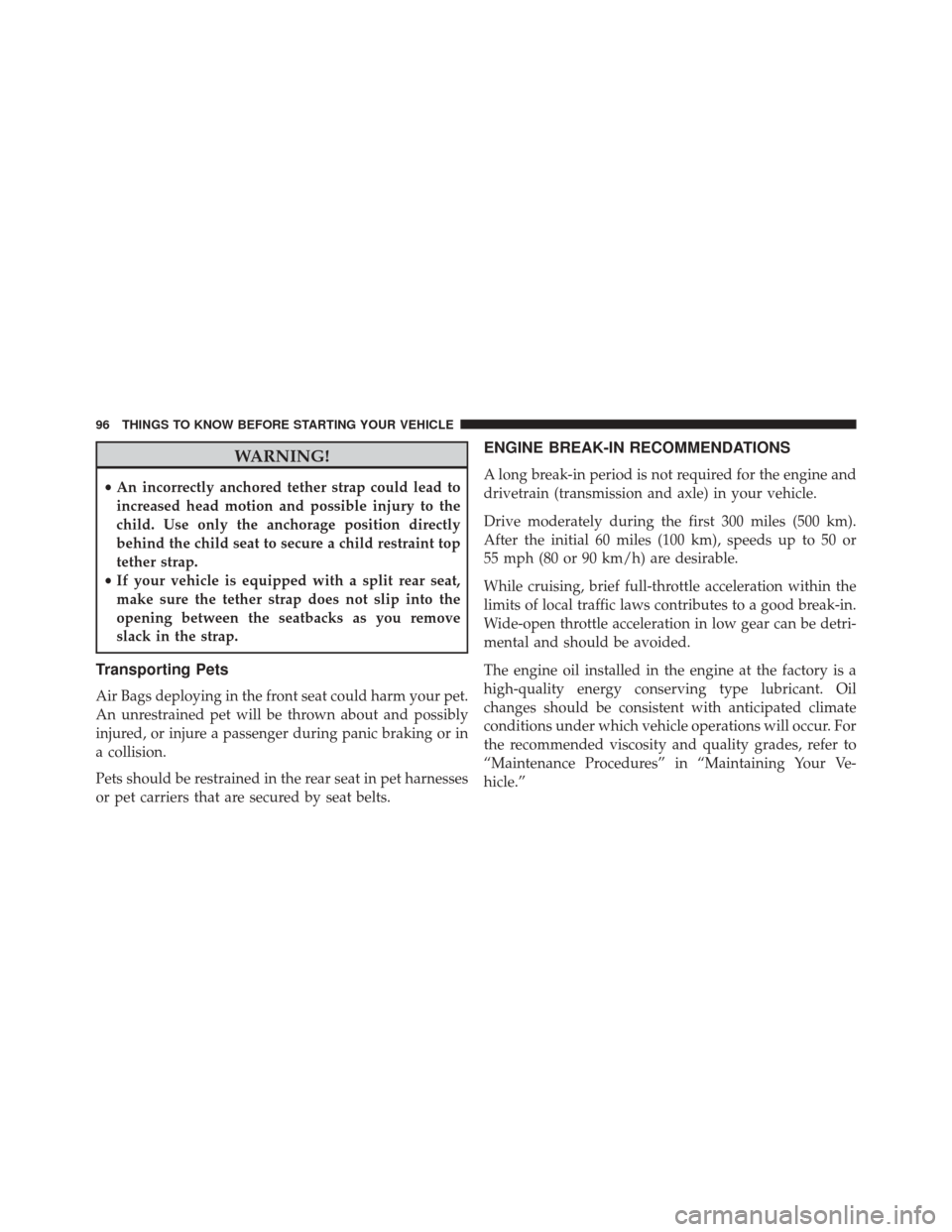
WARNING!
•An incorrectly anchored tether strap could lead to
increased head motion and possible injury to the
child. Use only the anchorage position directly
behind the child seat to secure a child restraint top
tether strap.
• If your vehicle is equipped with a split rear seat,
make sure the tether strap does not slip into the
opening between the seatbacks as you remove
slack in the strap.
Transporting Pets
Air Bags deploying in the front seat could harm your pet.
An unrestrained pet will be thrown about and possibly
injured, or injure a passenger during panic braking or in
a collision.
Pets should be restrained in the rear seat in pet harnesses
or pet carriers that are secured by seat belts.
ENGINE BREAK-IN RECOMMENDATIONS
A long break-in period is not required for the engine and
drivetrain (transmission and axle) in your vehicle.
Drive moderately during the first 300 miles (500 km).
After the initial 60 miles (100 km), speeds up to 50 or
55 mph (80 or 90 km/h) are desirable.
While cruising, brief full-throttle acceleration within the
limits of local traffic laws contributes to a good break-in.
Wide-open throttle acceleration in low gear can be detri-
mental and should be avoided.
The engine oil installed in the engine at the factory is a
high-quality energy conserving type lubricant. Oil
changes should be consistent with anticipated climate
conditions under which vehicle operations will occur. For
the recommended viscosity and quality grades, refer to
“Maintenance Procedures” in “Maintaining Your Ve-
hicle.”
96 THINGS TO KNOW BEFORE STARTING YOUR VEHICLE
Page 244 of 587
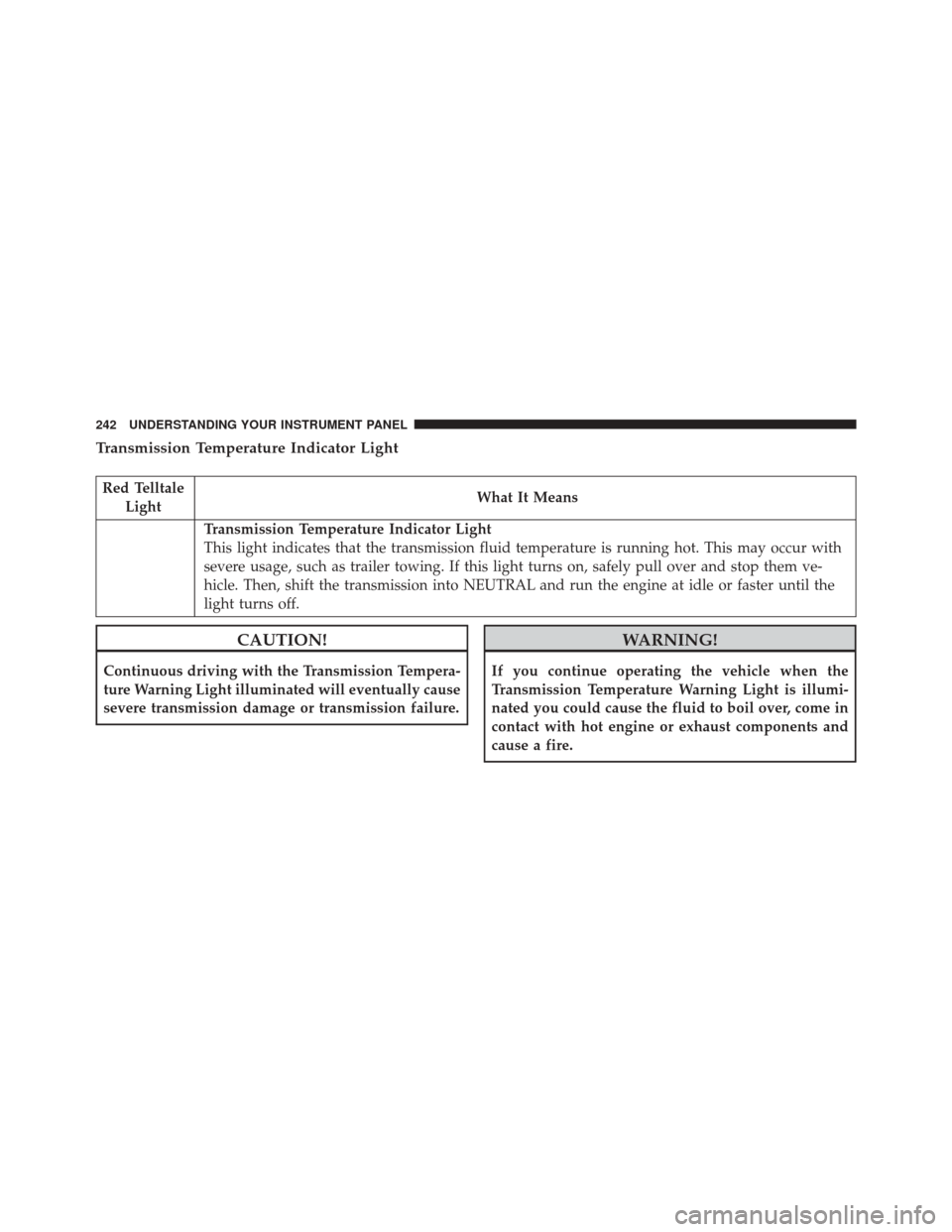
Transmission Temperature Indicator Light
Red TelltaleLight What It Means
Transmission Temperature Indicator Light
This light indicates that the transmission fluid temperature is running hot. This may occur with
severe usage, such as trailer towing. If this light turns on, safely pull over and stop them ve-
hicle. Then, shift the transmission into NEUTRAL and run the engine at idle or faster until the
light turns off.
CAUTION!
Continuous driving with the Transmission Tempera-
ture Warning Light illuminated will eventually cause
severe transmission damage or transmission failure.
WARNING!
If you continue operating the vehicle when the
Transmission Temperature Warning Light is illumi-
nated you could cause the fluid to boil over, come in
contact with hot engine or exhaust components and
cause a fire.
242 UNDERSTANDING YOUR INSTRUMENT PANEL
Page 357 of 587
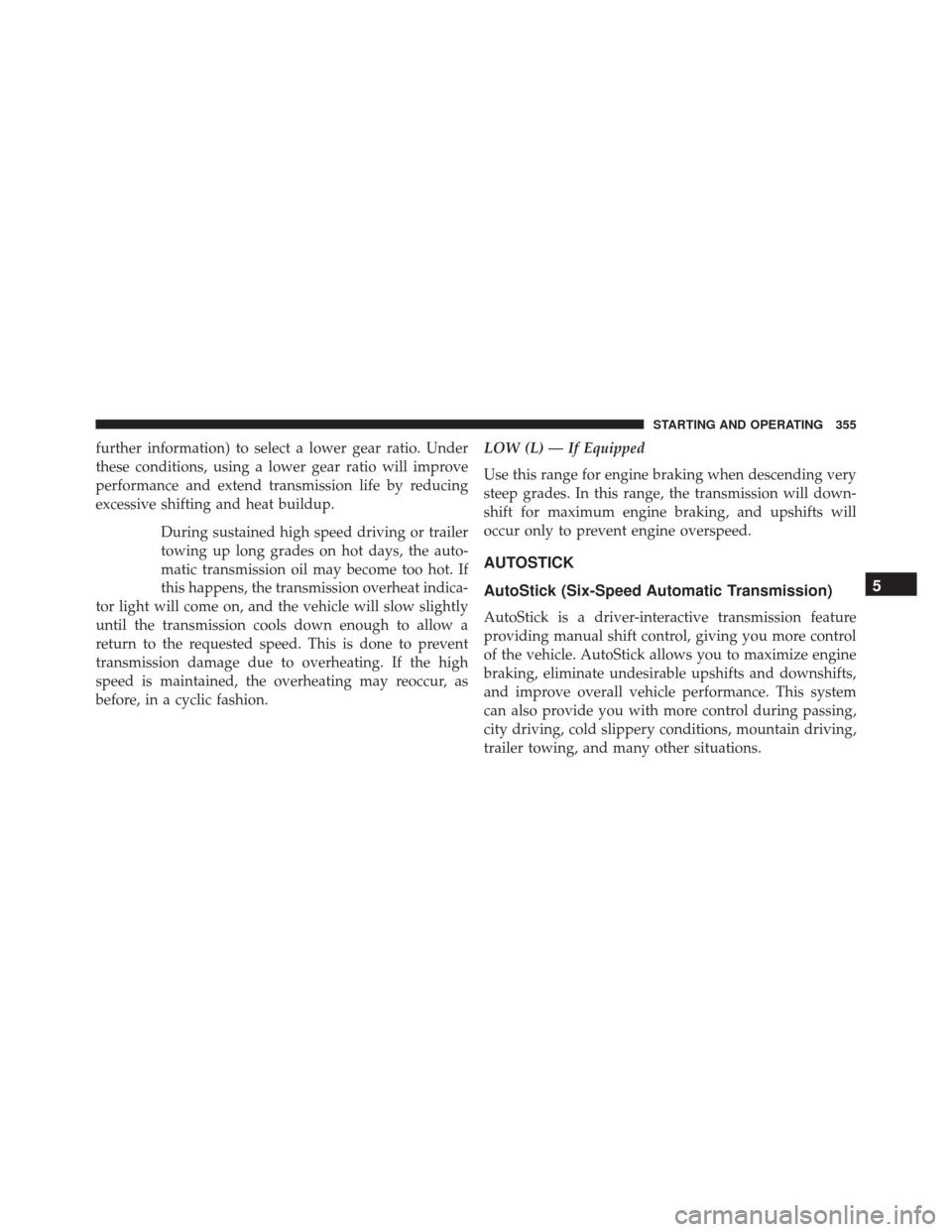
further information) to select a lower gear ratio. Under
these conditions, using a lower gear ratio will improve
performance and extend transmission life by reducing
excessive shifting and heat buildup.During sustained high speed driving or trailer
towing up long grades on hot days, the auto-
matic transmission oil may become too hot. If
this happens, the transmission overheat indica-
tor light will come on, and the vehicle will slow slightly
until the transmission cools down enough to allow a
return to the requested speed. This is done to prevent
transmission damage due to overheating. If the high
speed is maintained, the overheating may reoccur, as
before, in a cyclic fashion. LOW (L) — If Equipped
Use this range for engine braking when descending very
steep grades. In this range, the transmission will down-
shift for maximum engine braking, and upshifts will
occur only to prevent engine overspeed.
AUTOSTICK
AutoStick (Six-Speed Automatic Transmission)
AutoStick is a driver-interactive transmission feature
providing manual shift control, giving you more control
of the vehicle. AutoStick allows you to maximize engine
braking, eliminate undesirable upshifts and downshifts,
and improve overall vehicle performance. This system
can also provide you with more control during passing,
city driving, cold slippery conditions, mountain driving,
trailer towing, and many other situations.
5
STARTING AND OPERATING 355
Page 472 of 587
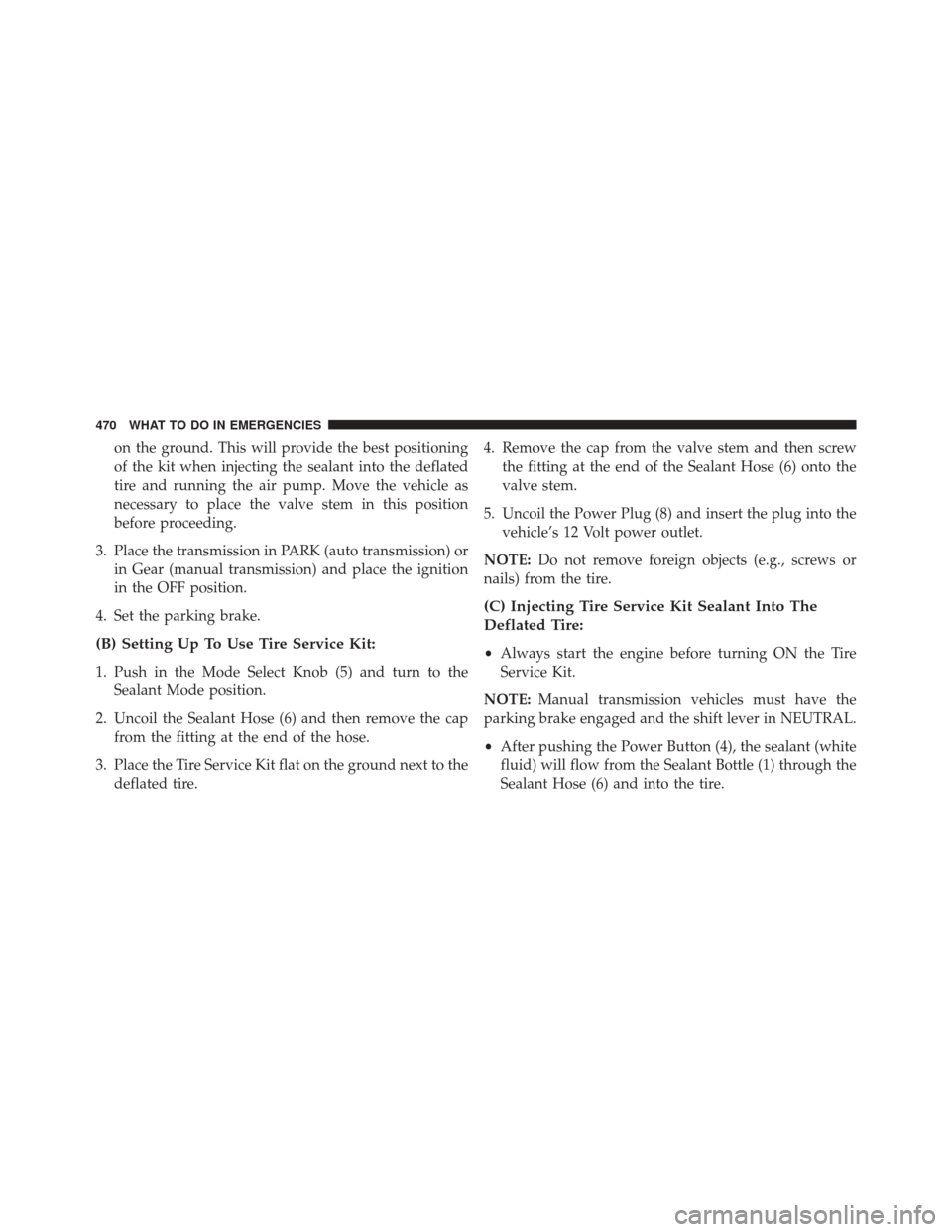
on the ground. This will provide the best positioning
of the kit when injecting the sealant into the deflated
tire and running the air pump. Move the vehicle as
necessary to place the valve stem in this position
before proceeding.
3. Place the transmission in PARK (auto transmission) or in Gear (manual transmission) and place the ignition
in the OFF position.
4. Set the parking brake.
(B) Setting Up To Use Tire Service Kit:
1. Push in the Mode Select Knob (5) and turn to the Sealant Mode position.
2. Uncoil the Sealant Hose (6) and then remove the cap from the fitting at the end of the hose.
3. Place the Tire Service Kit flat on the ground next to the deflated tire. 4. Remove the cap from the valve stem and then screw
the fitting at the end of the Sealant Hose (6) onto the
valve stem.
5. Uncoil the Power Plug (8) and insert the plug into the vehicle’s 12 Volt power outlet.
NOTE: Do not remove foreign objects (e.g., screws or
nails) from the tire.
(C) Injecting Tire Service Kit Sealant Into The
Deflated Tire:
• Always start the engine before turning ON the Tire
Service Kit.
NOTE: Manual transmission vehicles must have the
parking brake engaged and the shift lever in NEUTRAL.
• After pushing the Power Button (4), the sealant (white
fluid) will flow from the Sealant Bottle (1) through the
Sealant Hose (6) and into the tire.
470 WHAT TO DO IN EMERGENCIES
Page 497 of 587
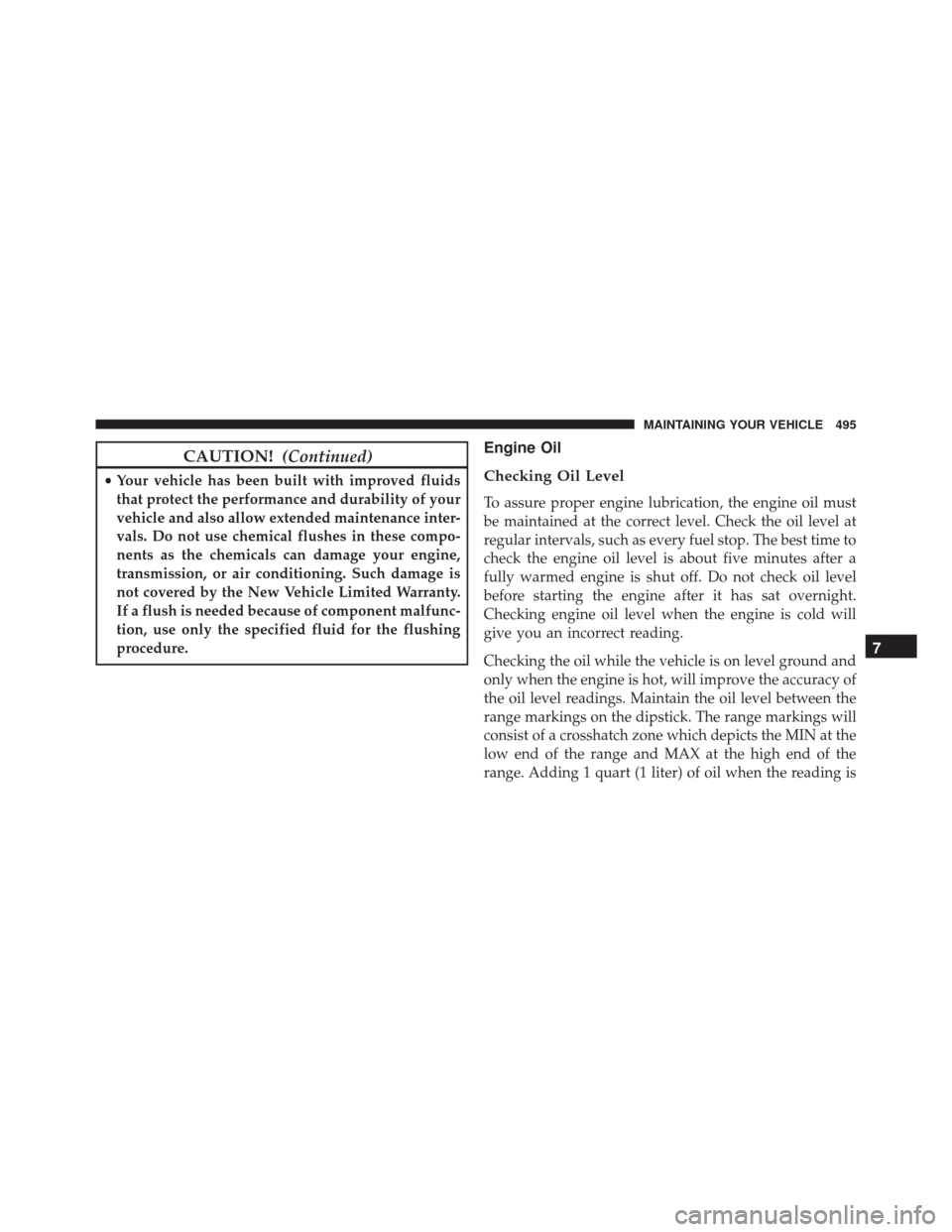
CAUTION!(Continued)
•Your vehicle has been built with improved fluids
that protect the performance and durability of your
vehicle and also allow extended maintenance inter-
vals. Do not use chemical flushes in these compo-
nents as the chemicals can damage your engine,
transmission, or air conditioning. Such damage is
not covered by the New Vehicle Limited Warranty.
If a flush is needed because of component malfunc-
tion, use only the specified fluid for the flushing
procedure.
Engine Oil
Checking Oil Level
To assure proper engine lubrication, the engine oil must
be maintained at the correct level. Check the oil level at
regular intervals, such as every fuel stop. The best time to
check the engine oil level is about five minutes after a
fully warmed engine is shut off. Do not check oil level
before starting the engine after it has sat overnight.
Checking engine oil level when the engine is cold will
give you an incorrect reading.
Checking the oil while the vehicle is on level ground and
only when the engine is hot, will improve the accuracy of
the oil level readings. Maintain the oil level between the
range markings on the dipstick. The range markings will
consist of a crosshatch zone which depicts the MIN at the
low end of the range and MAX at the high end of the
range. Adding 1 quart (1 liter) of oil when the reading is
7
MAINTAINING YOUR VEHICLE 495
Page 522 of 587
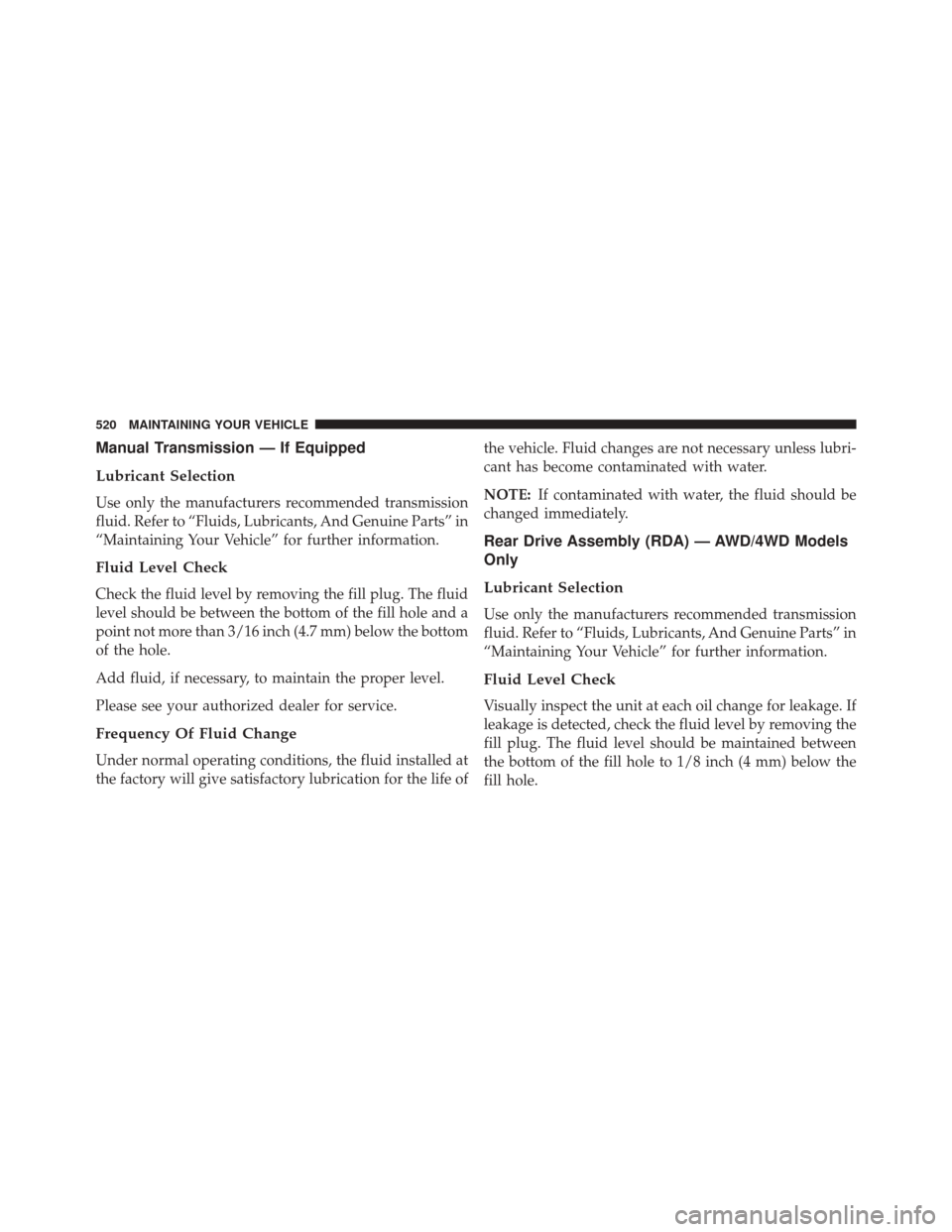
Manual Transmission — If Equipped
Lubricant Selection
Use only the manufacturers recommended transmission
fluid. Refer to “Fluids, Lubricants, And Genuine Parts” in
“Maintaining Your Vehicle” for further information.
Fluid Level Check
Check the fluid level by removing the fill plug. The fluid
level should be between the bottom of the fill hole and a
point not more than 3/16 inch (4.7 mm) below the bottom
of the hole.
Add fluid, if necessary, to maintain the proper level.
Please see your authorized dealer for service.
Frequency Of Fluid Change
Under normal operating conditions, the fluid installed at
the factory will give satisfactory lubrication for the life ofthe vehicle. Fluid changes are not necessary unless lubri-
cant has become contaminated with water.
NOTE:
If contaminated with water, the fluid should be
changed immediately.
Rear Drive Assembly (RDA) — AWD/4WD Models
Only
Lubricant Selection
Use only the manufacturers recommended transmission
fluid. Refer to “Fluids, Lubricants, And Genuine Parts” in
“Maintaining Your Vehicle” for further information.
Fluid Level Check
Visually inspect the unit at each oil change for leakage. If
leakage is detected, check the fluid level by removing the
fill plug. The fluid level should be maintained between
the bottom of the fill hole to 1/8 inch (4 mm) below the
fill hole.
520 MAINTAINING YOUR VEHICLE
Page 576 of 587
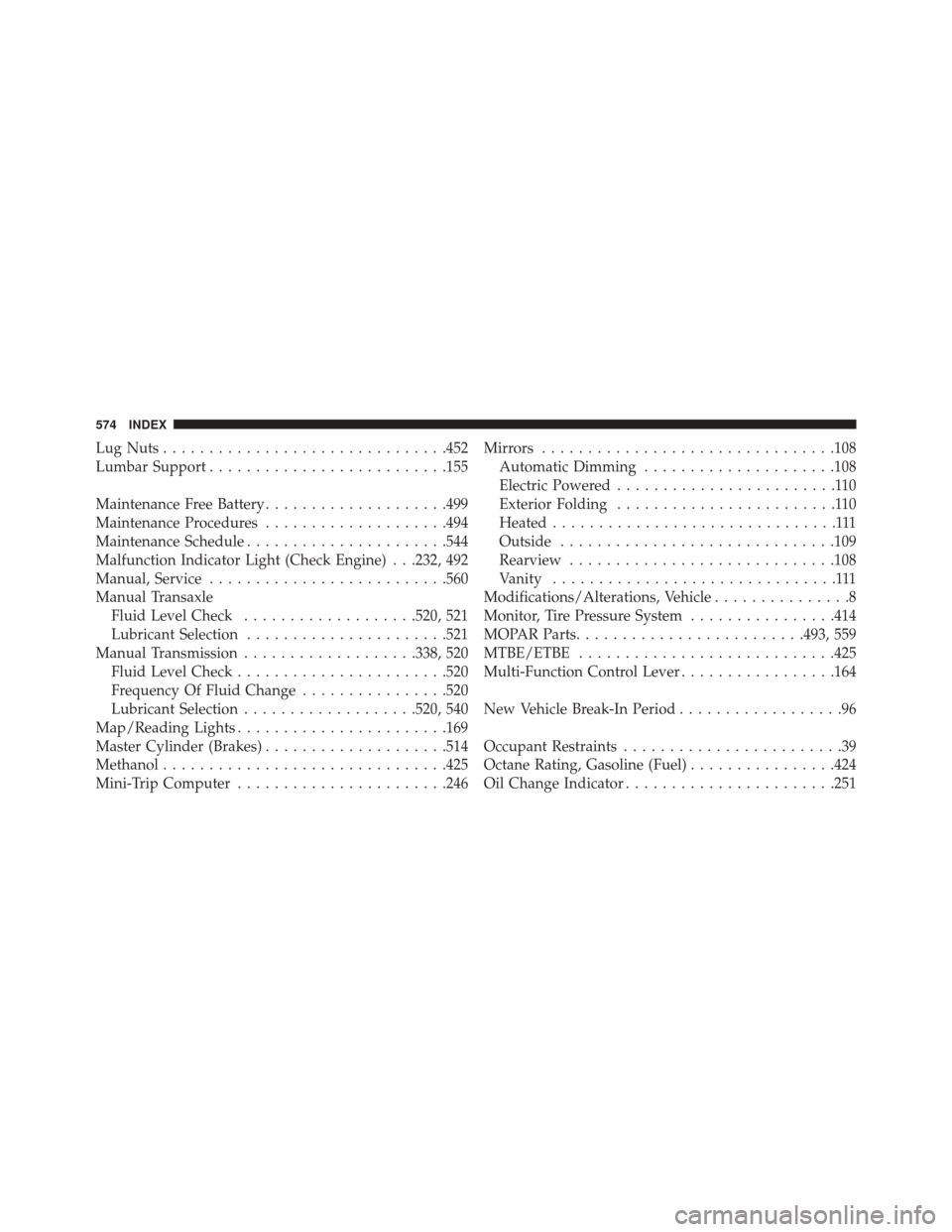
Lug Nuts.............................. .452
Lumbar Support ......................... .155
Maintenance Free Battery ....................499
Maintenance Procedures ....................494
Maintenance Schedule ..................... .544
Malfunction Indicator Light (Check Engine) . . .232, 492
Manual, Service ......................... .560
Manual Transaxle Fluid Level Check ...................520, 521
Lubricant Selection ..................... .521
Manual Transmission ...................338, 520
Fluid Level Check ...................... .520
Frequency Of Fluid Change ................520
Lubricant Selection ...................520, 540
Map/Reading Lights ...................... .169
Master Cylinder (Brakes) ....................514
Methanol .............................. .425
Mini-Trip Computer ...................... .246Mirrors
............................... .108
Automatic Dimming .....................108
Electric Powered ........................110
Exterior Folding ........................110
Heated ...............................111
Outside ............................. .109
Rearview ............................ .108
Vanity ...............................111
Modifications/Alterations, Vehicle ...............8
Monitor, Tire Pressure System ................414
MOPAR Parts ........................ .493, 559
MTBE/ETBE ........................... .425
Multi-Function Control Lever .................164
New Vehicle Break-In Period ..................96
Occupant Restraints ........................39
Octane Rating, Gasoline (Fuel) ................424
Oil Change Indicator ...................... .251
574 INDEX
Page 581 of 587
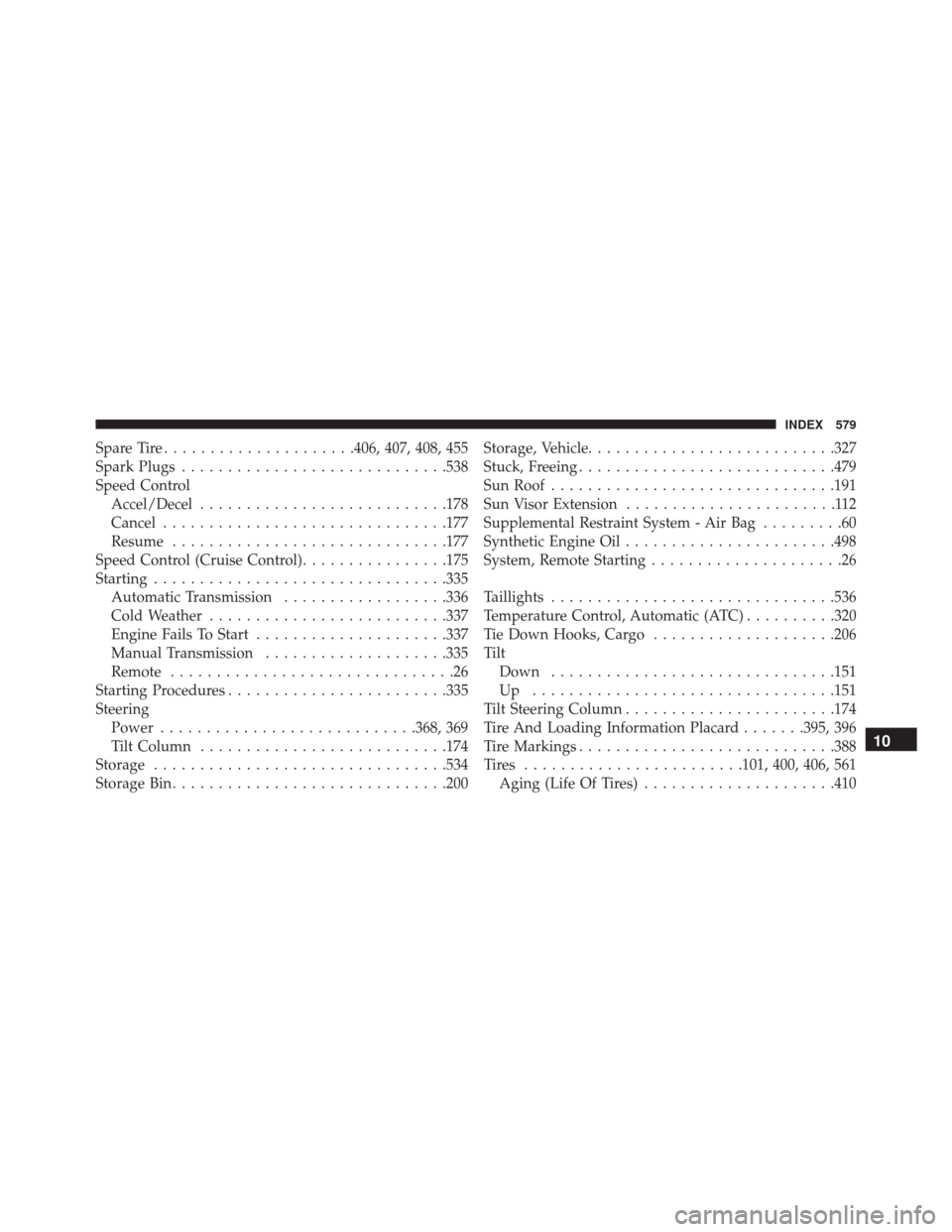
Spare Tire.....................406, 407, 408, 455
Spark Plugs ............................ .538
Speed Control Accel/Decel .......................... .178
Cancel .............................. .177
Resume ............................. .177
Speed Control (Cruise Control) ................175
Starting ............................... .335
Automatic Transmission ..................336
Cold Weather ......................... .337
Engine Fails To Start .....................337
Manual Transmission ....................335
Remote ...............................26
Starting Procedures ....................... .335
Steering Power ........................... .368, 369
Tilt Column .......................... .174
Storage ............................... .534
Storage Bin ............................. .200Storage, Vehicle
.......................... .327
Stuck, Freeing ........................... .479
Sun Roof .............................. .191
Sun Visor Extension .......................112
Supplemental Restraint System - Air Bag .........60
Synthetic Engine Oil ...................... .498
System, Remote Starting .....................26
Taillights .............................. .536
Temperature Control, Automatic (ATC) ..........320
Tie Down Hooks, Cargo ....................206
Tilt Down .............................. .151
Up ................................ .151
Tilt Steering Column ...................... .174
Tire And Loading Information Placard .......395, 396
Tire Markings ........................... .388
Tires ....................... .101, 400, 406, 561
Aging (Life Of Tires) .....................410
10
INDEX 579